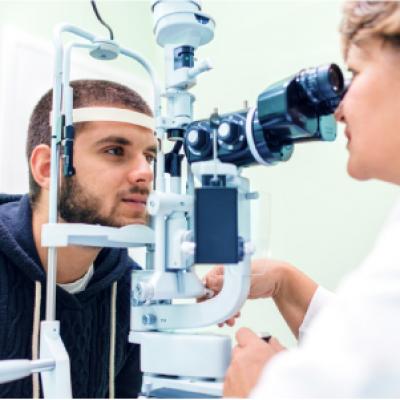Diabetic (retinopathy)
- Article
- 2021-01-31
Diabetic retinopathy is an eye condition that can cause vision loss and blindness in people with diabetes. It affects the blood vessels in the retina (the light-sensitive layer of tissue at the back of your eye). If you have diabetes, it is important to have a comprehensive enlarged eye exam at least once a year. Diabetic retinopathy may not have symptoms at first, but finding it early can help you take steps to protect your vision. Managing your diabetes - by staying physically active, eating a healthy diet, and taking your medications - can also help you prevent or delay vision loss. Diabetic retinopathy is the most common cause of vision loss in people with diabetes. But diabetes can also make you more likely to develop several other eye conditions: The early stages of diabetic retinopathy usually have no symptoms. Some people notice changes in their vision, such as difficulty reading or seeing distant objects. These changes can come and go. In later stages of the disease, blood vessels in the retina begin to bleed into the vitreous humor (gel-like fluid in the center of the eye). When this happens, you may see dark, floating spots or streaks that resemble spider webs. Sometimes the spots go away on their own, but it's important to get treatment right away. Without treatment, the bleeding can recur, get worse, or cause scarring. Diabetic retinopathy can lead to other serious eye conditions: Anyone with any form of diabetes can get diabetic retinopathy - including people with type 1, type 2, and gestational diabetes (diabetes that can develop during pregnancy). Your risk increases the longer you have diabetes. More than 2 in 5 Americans with diabetes have a stage of diabetic retinopathy. The good news is that you can lower your risk of developing diabetic retinopathy by controlling your diabetes. Women with diabetes who become pregnant - or women who develop gestational diabetes - are at high risk of developing diabetic retinopathy. If you have diabetes and are pregnant, you should have a comprehensive eye exam as soon as possible. Ask your doctor if you need additional eye exams during your pregnancy. Diabetic retinopathy is caused by high blood sugar due to diabetes. Over time, too much sugar in your blood can damage your retina - the part of your eye that detects light and sends signals to your brain through a nerve in the back of your eye (optic nerve). Diabetes damages blood vessels throughout the body. The damage to your eyes starts when sugar blocks the tiny blood vessels that go to your retina, causing them to leak fluid or bleed. To make up for these clogged blood vessels, your eyes grow new blood vessels that don't work properly. These new blood vessels can leak or bleed easily. Ophthalmologists can monitor diabetic retinopathy as part of an enlarged eye exam. The exam is simple and painless - your doctor will give you some eye drops to dilate (dilate) your pupil, then check your eyes for diabetic retinopathy and other eye problems. If you have diabetes, it is very important to have regular eye exams. If you develop diabetic retinopathy, early treatment can stop the damage and prevent blindness. If your eye doctor thinks you may have severe diabetic or retinopathy Did you not find what you were looking for? Search further in the
Other types of diabetic eye disease
What Are the Symptoms of Diabetic Retinopathy?
What other problems can diabetic retinopathy cause?
Am I at risk for diabetic retinopathy?
What Causes Diabetic Retinopathy?
How does my eye doctor check for diabetic retinopathy?

